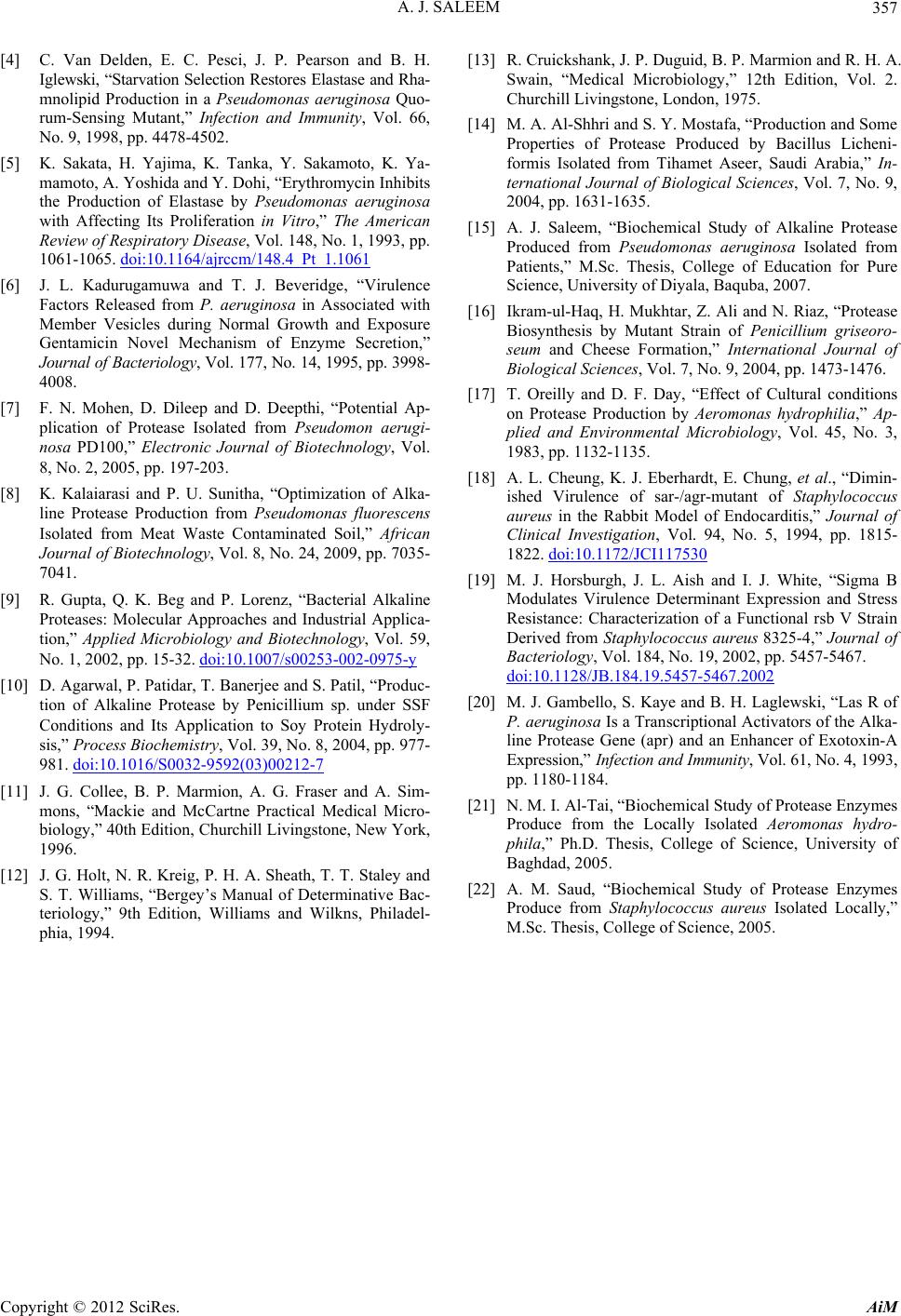
A. J. SALEEM 357
[4] C
. Van Delden, E. C. Pesci, J. P. Pearson and B. H.
Iglewski, “Starvation Selection Restores Elastase and Rha-
mnolipid Production in a Pseudomonas aeruginosa Quo-
rum-Sensing Mutant,” Infection and Immunity, Vol. 66,
No. 9, 1998, pp. 4478-4502.
[5] K. Sakata, H. Yajima, K. Tanka, Y. Sakamoto, K. Ya-
mamoto, A. Yoshida and Y. Dohi, “Erythromycin Inhibits
the Production of Elastase by Pseudomonas aeruginosa
with Affecting Its Proliferation in Vitro,” The American
Review of Respiratory Disease, Vol. 148, No. 1, 1993, pp.
1061-1065. doi:10.1164/ajrccm/148.4_Pt_1.1061
[6] J. L. Kadurugamuwa and T. J. Beveridge, “Virulence
Factors Released from P. aeruginosa in Associated with
Member Vesicles during Normal Growth and Exposure
Gentamicin Novel Mechanism of Enzyme Secretion,”
Journal of Bacteriology, Vol. 177, No. 14, 1995, p p. 3998-
4008.
[7] F. N. Mohen, D. Dileep and D. Deepthi, “Potential Ap-
plication of Protease Isolated from Pseudomon aerugi-
nosa PD100,” Electronic Journal of Biotechnology, Vol.
8, No. 2, 2005, pp. 197-203.
[8] K. Kalaiarasi and P. U. Sunitha, “Optimization of Alka-
line Protease Production from Pseudomonas fluorescens
Isolated from Meat Waste Contaminated Soil,” African
Journal of Biotechnology, Vol. 8, No. 24, 2009, pp. 7035-
7041.
[9] R. Gupta, Q. K. Beg and P. Lorenz, “Bacterial Alkaline
Proteases: Molecular Approaches and Industrial Applica-
tion,” Applied Microbiology and Biotechnology, Vol. 59,
No. 1, 2002, pp. 15-32. doi:10.1007/s00253-002-0975-y
[10] D. Agarwal, P. Patidar, T. Banerjee and S. Patil, “Produc-
tion of Alkaline Protease by Penicillium sp. under SSF
Conditions and Its Application to Soy Protein Hydroly-
sis,” Process Bioc hemistry , Vol. 39, No. 8, 2004, pp. 977-
981. doi:10.1016/S0032-9592(03)00212-7
[11] J. G. Collee, B. P. Marmion, A. G. Fraser and A. Sim-
mons, “Mackie and McCartne Practical Medical Micro-
biology,” 40th Edition, Churchill Livingstone, New York,
1996.
[12] J. G. Holt, N. R. Kreig, P. H. A. Sheath, T. T. Staley and
S. T. Williams, “Bergey’s Manual of Determinative Bac-
teriology,” 9th Edition, Williams and Wilkns, Philadel-
phia, 1994.
[13] R. Cruickshank, J. P. Duguid, B. P. Marmion and R. H. A.
Swain, “Medical Microbiology,” 12th Edition, Vol. 2.
Churchill Livingstone, London, 1975.
[14] M. A. Al-Shhri and S. Y. Mostafa, “Production and Some
Properties of Protease Produced by Bacillus Licheni-
formis Isolated from Tihamet Aseer, Saudi Arabia,” In-
ternational Journal of Biological Sciences, Vol. 7, No. 9,
2004, pp. 1631-1635.
[15] A. J. Saleem, “Biochemical Study of Alkaline Protease
Produced from Pseudomonas aeruginosa Isolated from
Patients,” M.Sc. Thesis, College of Education for Pure
Science, University of Diyala, Baquba, 2007.
[16] Ikram-ul-Haq, H. Mukhtar, Z. Ali and N. Riaz, “Protease
Biosynthesis by Mutant Strain of Penicillium griseoro-
seum and Cheese Formation,” International Journal of
Biological Sciences, Vol. 7, No. 9, 2004, pp. 1473-1476.
[17] T. Oreilly and D. F. Day, “Effect of Cultural conditions
on Protease Production by Aeromonas hydrophilia,” Ap-
plied and Environmental Microbiology, Vol. 45, No. 3,
1983, pp. 1132-1135.
[18] A. L. Cheung, K. J. Eberhardt, E. Chung, et al., “Dimin-
ished Virulence of sar-/agr-mutant of Staphylococcus
aureus in the Rabbit Model of Endocarditis,” Journal of
Clinical Investigation, Vol. 94, No. 5, 1994, pp. 1815-
1822. doi:10.1172/JCI117530
[19] M. J. Horsburgh, J. L. Aish and I. J. White, “Sigma B
Modulates Virulence Determinant Expression and Stress
Resistance: Characterization of a Functional rsb V Strain
Derived from Staphylococcus aureus 8325-4,” Journal of
Bacteriology, Vol. 184, No. 19, 2002, pp. 5457-5467.
doi:10.1128/JB.184.19.5457-5467.2002
[20] M. J. Gambello, S. Kaye and B. H. Laglewski, “Las R of
P. aeruginosa Is a Transcriptional Activators of the Alka-
line Protease Gene (apr) and an Enhancer of Exotoxin-A
Expression,” I nfection and Immunity, Vol. 6 1, No. 4, 1993,
pp. 1180-1184.
[21] N. M. I. Al-Tai, “Biochemical Study of Protease Enzymes
Produce from the Locally Isolated Aeromonas hydro-
phila,” Ph.D. Thesis, College of Science, University of
Baghdad, 2005.
[22] A. M. Saud, “Biochemical Study of Protease Enzymes
Produce from Staphylococcus aureus Isolated Locally,”
M.Sc. Thesis, College of Science, 2005.
Copyright © 2012 SciRes. AiM